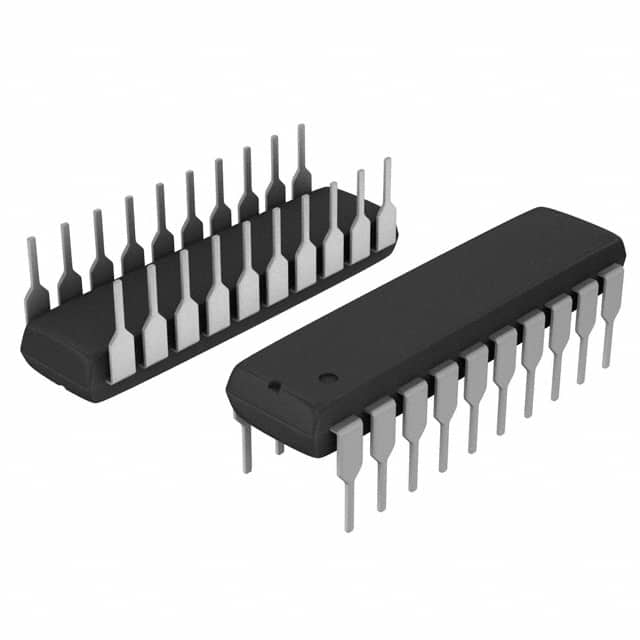Xem thông số kỹ thuật để biết chi tiết sản phẩm.

PIC16C432-E/P
Product Overview
Category
The PIC16C432-E/P belongs to the category of microcontrollers.
Use
This microcontroller is commonly used in various electronic devices and embedded systems for controlling and processing data.
Characteristics
- Low power consumption
- High performance
- Small form factor
- Wide operating voltage range
- Integrated peripherals for enhanced functionality
Package
The PIC16C432-E/P is available in a 40-pin PDIP (Plastic Dual In-line Package) package.
Essence
The essence of the PIC16C432-E/P lies in its ability to provide efficient control and processing capabilities in a compact and low-power package.
Packaging/Quantity
The PIC16C432-E/P is typically packaged in tubes or trays, with quantities varying based on customer requirements.
Specifications
- Microcontroller architecture: 8-bit
- CPU speed: Up to 20 MHz
- Program memory size: 4 KB
- RAM size: 256 bytes
- Number of I/O pins: 33
- ADC channels: 5
- Timers: 2
- Communication interfaces: UART, SPI, I2C
Detailed Pin Configuration
The PIC16C432-E/P features a total of 40 pins, each serving a specific purpose. The pin configuration is as follows:
- VDD - Power supply
- RA0 - General-purpose I/O pin
- RA1 - General-purpose I/O pin
- RA2 - General-purpose I/O pin
- RA3 - General-purpose I/O pin
- RA4 - General-purpose I/O pin
- RA5 - General-purpose I/O pin
- MCLR - Master Clear input
- OSC1 - Oscillator input
- OSC2 - Oscillator output
- RC0 - General-purpose I/O pin
- RC1 - General-purpose I/O pin
- RC2 - General-purpose I/O pin
- RC3 - General-purpose I/O pin
- RC4 - General-purpose I/O pin
- RC5 - General-purpose I/O pin
- VSS - Ground
... (continued for remaining pins)
Functional Features
The PIC16C432-E/P offers several functional features that enhance its usability and performance:
- Integrated ADC for analog signal processing
- Timers for precise timing control
- Communication interfaces for data exchange with other devices
- Interrupt capability for handling real-time events
- Low-power modes for energy efficiency
- On-chip debugging support for easy development and troubleshooting
Advantages and Disadvantages
Advantages
- Compact size allows for integration in space-constrained designs
- Low power consumption extends battery life in portable applications
- High-performance CPU enables fast data processing
- Wide operating voltage range accommodates various power supply options
- Integrated peripherals reduce the need for external components
Disadvantages
- Limited program memory size may restrict the complexity of applications
- 8-bit architecture may not be suitable for certain demanding tasks
- Lack of advanced features found in more modern microcontrollers
Working Principles
The PIC16C432-E/P operates based on the Von Neumann architecture, where it fetches instructions from program memory and executes them sequentially. It utilizes a combination of registers, timers, and peripherals to perform various tasks. The microcontroller can be programmed using assembly language or high-level programming languages.
Detailed Application Field Plans
The PIC16C432-E/P finds application in a wide range of fields, including but not limited to: - Home automation systems - Industrial control systems - Automotive electronics - Medical devices - Consumer electronics
Detailed and Complete Alternative Models
Some alternative models to the PIC16C432-E/P that offer similar functionality and features include: - PIC16F432-E/P - PIC18F432-E/P - ATmega32A - STM32F103C8T6
These alternatives provide options for developers based on their specific requirements and preferences.
In conclusion, the PIC16C432-E/P is a versatile microcontroller with various features and capabilities. Its compact size, low power consumption, and integrated peripherals make it suitable for a wide range of applications. However, its limited program memory and 8-bit architecture may pose limitations in certain scenarios. Developers can consider alternative models based on their specific needs.
Liệt kê 10 câu hỏi và câu trả lời thường gặp liên quan đến ứng dụng PIC16C432-E/P trong giải pháp kỹ thuật
What is the maximum operating frequency of PIC16C432-E/P?
- The maximum operating frequency of PIC16C432-E/P is 20 MHz.What are the key features of PIC16C432-E/P?
- The key features of PIC16C432-E/P include 8-bit microcontroller, 5-channel 8-bit A/D converter, and 256 bytes of EEPROM data memory.Can PIC16C432-E/P be used in battery-powered applications?
- Yes, PIC16C432-E/P can be used in battery-powered applications due to its low power consumption.What programming language is commonly used for PIC16C432-E/P?
- Assembly language and C are commonly used for programming PIC16C432-E/P.Is PIC16C432-E/P suitable for motor control applications?
- Yes, PIC16C432-E/P is suitable for motor control applications due to its integrated PWM module.What communication interfaces are supported by PIC16C432-E/P?
- PIC16C432-E/P supports USART, SPI, and I2C communication interfaces.Can PIC16C432-E/P be used in temperature sensing applications?
- Yes, PIC16C432-E/P can be used in temperature sensing applications with its built-in analog-to-digital converter.What development tools are available for PIC16C432-E/P?
- Development tools such as MPLAB X IDE and PICkit programmers are available for PIC16C432-E/P.Is PIC16C432-E/P suitable for industrial automation applications?
- Yes, PIC16C432-E/P is suitable for industrial automation applications due to its robust design and peripheral integration.What are the recommended operating conditions for PIC16C432-E/P?
- The recommended operating voltage range for PIC16C432-E/P is 2.0V to 5.5V, and the temperature range is -40°C to 125°C.

